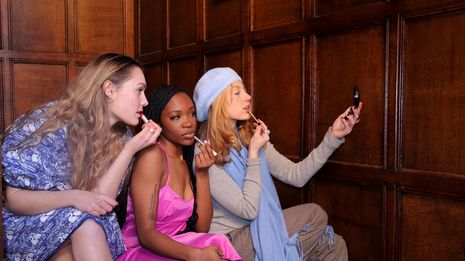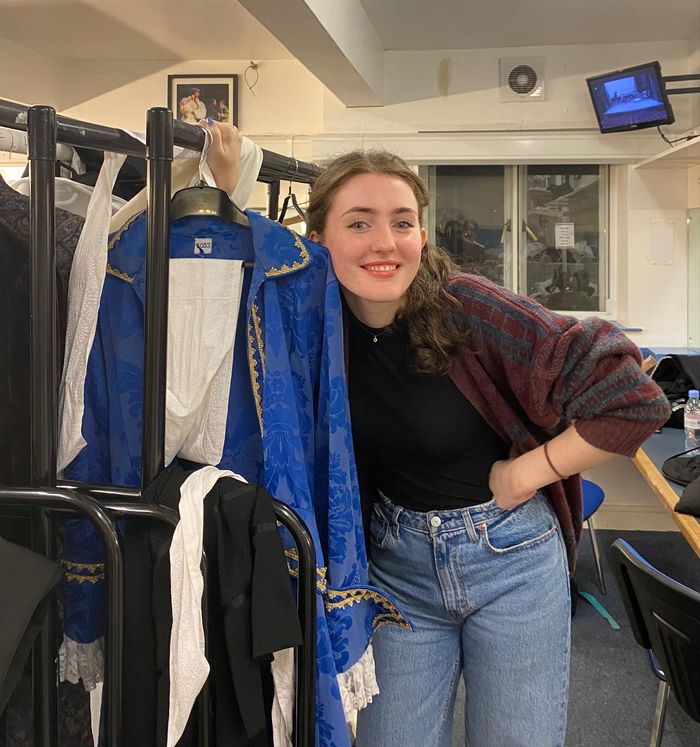‘We’re going for nepo-baby core’: Marie Antoinette’s costume designer on its Y2K reimagining
Speaking to the show’s costume designer, Mel Hamilton, Corpus Playroom’s upcoming Marie Antoinette reveals itself to be less rococo extravaganza and more Hailey Bieber ‘nepo baby’ tee

With some of the best marketing I’ve ever seen for a Cambridge show in my time, Corpus Playroom’s upcoming Marie Antoinette has developed a very distinct aesthetic for itself. Pulling the tale out of 18th-century France, this production is giving less rococo extravaganza and more Y2K nepo-baby. Sitting down with the show’s costume designer, Mel Hamilton, she explains that she initially planned to audition for the play but realised “what I really like is the aesthetic and a better way to get involved in the production would be costume”. Asking her to describe the show’s so magnetic look she replies, “we’re going for nepo-baby core… hyper-influencer, very feminine, very indulgent with loads of pearls, loads of gold - which is really my own style”, referencing her own gold jewellery with a laugh.
“This production is giving less rococo extravaganza and more Y2K nepo-baby”
She explains that the show’s themes of “control and power and ignorance”, despite being rooted in the 1700s, are “very relevant at the moment”. Her goal is to make this potentially unrelatable story “relatable and universal. Because obviously the idea of aristocracy isn’t accessible to everybody but the idea of someone wearing a Y2K baby tee” - think Paris Hilton’s ‘Stop Being Poor’ vest – “kind of is.” Delving deeper into this world of socialites and influencers, I ask which modern-day nepo-babies the show’s characters most emulate. Mel says “for me Marie is very Lily Rose-Depp” because of “the idea that her father is a very big actor and she’s sort of an actress”. She also suggests that Ansel Elgort is very “Louis vibes.” When trying to think who to compare next she ponders “who else is a nepo-baby?” then answering her own question as she realises “I feel like everybody’s a nepo-baby.”
As an 18th-century lover myself I was curious to know how she was planning to incorporate the style of the period. She explains that despite the modern take, she wanted to have the rough “silhouette of what they would’ve worn” as well as incorporating the “indulgence”. She says that “Marie has a lot of layers and white stockings and things”, making it “a lot easier to go around” she jokes as we wonder how she would have possibly been able to make and squeeze 18th-century ballgowns into the Corpus Playroom. “First meeting was like we’re not doing bustles,” she quips.
“There’s this sort of timeless aspect to it”
Although the look is certainly not going for historical accuracy, we discuss how she drew inspiration from the 2006 period film Marie Antoinette. Mel says she admires how the film successfully costumes the characters in colours that “complement their relationships”, explaining how she put “Marie in quite pink clothing” because “she’s having an affair with Axel Fersen” who she “put in blue so you’ve got them in baby pink and baby blue so it’s like maybe they would be more suited.” Exploring this symbolism, we reflect on the importance of costume as a form of storytelling. Mel says that “at its core, the show is about indulgence and the power that money and status have. And at the time the way that was most conspicuously shown was through what they were wearing.” She explains that with the story’s parallels to the present day “there’s this sort of timeless aspect to it. I think you could put it into the future and it would still work.” Apparently we’ll never be able to escape the elitist power of wealthy bloodlines.
One of the characters I was most interested in the costuming of was the sheep. She recalls seeing the script and being like “hold on! Where is the sheep in Marie Antoinette?!”. Viewing the sheep as the “amalgamation of Marie’s fears”, she tells me what she “liked about the sheep’s jacket is that it’s very long. And it’s kind of ominous in that sense because it’s perhaps like the grim reaper if we’re making a stretch.” She also reflects on her choice to make it “a white sheep rather than a black sheep. Like the sheep isn’t bad, it’s probably the person whose correct in the show.” I can’t help feeling these questions about the sheep have only left me with more questions than answers.
Looking at the costumes of the other characters, I ask her what item of clothing best describes them all. For Marie, she instantly says “corset. Think baby pink corset over white work shirt because it’s like ‘ooh she’s appropriating the work man’s wear’” – a lovely reference to Marie’s cottage-core peasant appropriating past-times. For Louis, she says “a little black neckerchief – very cutthroat” she says with a proud laugh. “Fersen: some blue jeans” she decides, “he brings Marie down to earth a bit.” Overall she says “it’s a really amazing thing Ariana” (the show’s director) “has done with her vision. The cast is amazing and so is Ariana, and I love this show.”
 News / Clare Hall spent over £500k opposing busway 24 December 2025
News / Clare Hall spent over £500k opposing busway 24 December 2025 Comment / The ‘class’ of Cambridge24 December 2025
Comment / The ‘class’ of Cambridge24 December 2025 News / Eight Cambridge researchers awarded €17m in ERC research grants27 December 2025
News / Eight Cambridge researchers awarded €17m in ERC research grants27 December 2025 News / Caius mourns its tree-mendous loss23 December 2025
News / Caius mourns its tree-mendous loss23 December 2025 Comment / League tables do more harm than good26 December 2025
Comment / League tables do more harm than good26 December 2025









